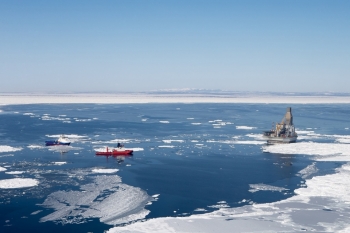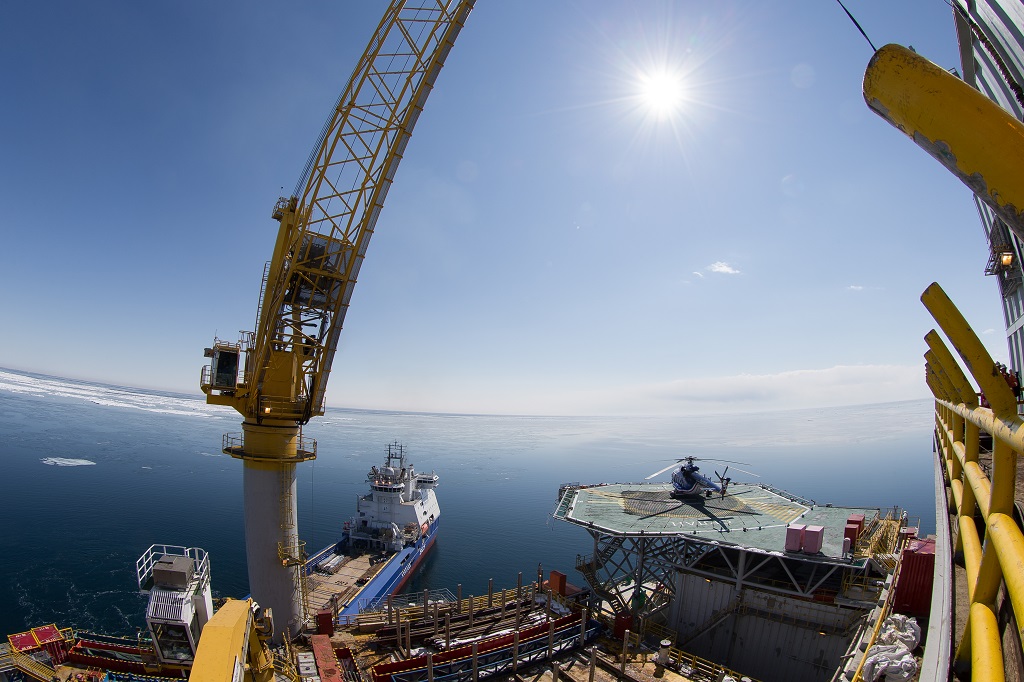Please activate JavaScript in your browser to use all interface options.
Sakhalin-1 Sets Another Extended Reach Drilling Record
14 April 2015
Rosneft as part of Sakhalin-1 Consortium has successfully completed drilling of the world’s longest well at the Chayvo field.
O-14 production well was drilled with Orlan drilling platform in direction of the field’s south-eastern point. The well has the world-record measured depth of 13,500 meters and a horizontal reach of 12,033 meters.

Since the beginning of drilling program in 2003, Sakhalin-1 has set several world records in extended reach well drilling. With this accomplishment, the Sakhalin-1 consortium currently holds drilling records for 9 of the 10 world’s longest wells.
In 2013, two consecutive world records for measured depth were set as part of the Sakhalin-1 project. In April of that year, the Z-43 well reached 12,450 meters of measured depth and in June the Z-42 well reached 12,700 meters and a horizontal reach of 11,739 meters. In April 2014, the drilling team drilled and completed Z-40 well at the offshore field Chayvo of the Sakhalin-1 project. Until the completion of O-14 well this well had a record measured depth of 13,000 meters and horizontal reach of 12,130 meters.
Sakhalin-1 extended reach drilling is among the fastest due to the use of ExxonMobil’s proprietary Fast Drill process. This technology allows bottleneck identification in the drilling process and solution development to enable optimal drilling and completions.

Successful implementation of these state-of-the-art technologies reduces costs associated with additional offshore facilities, pipelines and other production infrastructure. They also protect the environment by minimizing areas involved in drilling and production operations.
Rosneft Head Igor Sechin said: “This well continues successful implementation of our outstanding project. I would like to express my thanks to our partners – ExxonMobil. Usage of their drilling technologies made this achievement possible”.
Notes for editors:
hayvo is one of the three fields of Sakhalin-1 project. It is located in the north-east from the Sakhalin shore. Sea depth ranges from 14 m to 30 m. Sea depth at the block of the Orlan platform installation including drilling and accommodation units is 15 m, the distance from the shore is 5 km (close border) and 15 km (distant border). The field was put into operation in 2005.
Installation of the Orlan platform was completed in July 2005 and drilling works started in December 20015. The range of production processing constructions at the platform is minimized as all production is being delivered to the Chayvo onshore processing facility. Steel concrete basement of Orlan easily withstands pressure of ice and giant hummocks that reach the altitude of a six-floor-building.
Sakhalin-1 is the first large-scale offshore project carried out in the Russian Federation on the PSA conditions (executed in 1996).
Shares of the project participants:
- Rosneft - 20%
- ExxonMobil – 30%
- SODECO – 30%
- ONGC Videsh Ltd. – 20%
Sakhalin-1 project includes development of three offshore fields: Chayvo, Odoptu and Arkutun-Dagi, which are situated at north-eastern shelf of the Sakhalin Island. Ultimate recoverable reserves of the project are 236 mln tons of oil and 487 bln m3 of gas. In 2005 the Chayvo field was put into operation, in 2010 – the Odoptu field and in January of 2015 – Arkutun-Dagi field. Since the start of the project’s implementation 80 mln tons of oil were produced, 16 bln m3 of gas were produced and marketed.
Rosneft Information Division
Tel.: + 7 (499) 517-88-97
April 14, 2015
These materials contain statements about future events and expectations that are forward-looking. Any statement in these materials which is not information for prior accounting periods is an expectation and related to known and unknown risks, uncertainties or other factors, which can make the actual results, performance or achievements differ substantially from those anticipated and implied in these forward-looking statements directly or indirectly. We assume no obligation to update the data contained herein, to reflect actual results, changes in assumptions or factors affecting these statements.

-315xx70.png)

